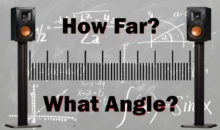How Much Amplifier Power Do I Need?
It’s a common question: “How much amplifier power do I need?” We get asked all the time about power requirements to drive anything from large tower speakers to small satellites or non-amplified soundbar speakers. There’s a simple solution to the question—but it may not be what you might at first think.
How Big is Your Room?
Before we can answer the question of how much amplifier power you need, we have to ask what the room and venue will look like. Are you attempting to power a small home theater? Are you looking to run some powerful outdoor speakers or a whole-home audio system from a multi-channel amplifier? The answer to the question will determine, at least partially, how much power you need to drive your speakers. A bigger room will invariably require more power, and when you go outdoors, you almost never have enough (provided your speakers are sufficiently rated. This brings us to our next point.
What Do Your Speakers Tell You?
Every pair of speakers I know of gives you a rating for their power handling. This is a range of power that the speakers can handle. Find that range…and then ignore it. Just kidding.
Sort of.
You see, while speakers will give their power ratings in a range, those ranges are typically very wide—and they don’t take into account the quality of the audio going into them at those power ranges. A massively distorted signal can blow a speaker at lower levels much faster than a clean signal will at high levels. The bottom line is that you want to have an amplifier that can drive the speakers hard enough that you don’t need to be maxing out every part of the signal chain in order to get the music loud enough for the speakers. That’s where you start to run into messy audio and risk damaging your drivers.
Some good specifications to understand are the “Nominal Impedance” and “Continuous Power Handling” ratings (sometimes it’s called the “IEC rated power”). With those two numbers you can figure out the ballpark on where you want your amplifier power to fall. In general, for a typical home theater, you want to use speakers that have 4-ohm nominal impedance or greater. Most speakers today are 8-ohm nominal, but you can find exceptions. At 8-ohms, you want to have an amplifier that provides at least twice the power of the “continuous Power Handling” spec. That will keep you from sending lots of clipped audio to the speaker and damaging it over time. It sounds counterintuitive, but it’s not—you need more available power than what your speakers are rated for, not less.
The reason for this is because your speakers and your amplifier need to be able to handle the peaks found in most music and soundtracks. It’s those peaks that defy the “Nominal” numbers and which demand some extra power and additional power handling.
What’s Your Application?
This section is a bit tricky. It takes the above into consideration but adds one additional factor: What are you listening to? If you’re looking to play fairly mellow tunes, then you can get away with a wide range of amplifier power that falls within the specs of your loudspeakers. If, however, you’re looking at more dynamic music, then you may want to ensure you have two to three times the nominal rated power for your speakers so that you can handle the peaks associated with more dynamic tracks.
Calculating Amplifier Requirements—Oh No, Math!
When you’re doing the math, the amplifier power rating must match the impedance rating for your speakers. If not, then you need to do some conversions.
Don’t worry, this won’t hurt…much.
If your loudspeakers are rated to 8-ohms, chances are you’re just fine as most amplifiers are rated to 8-ohms (in addition to other ratings they may have). If your speakers are rated to 4-ohms, however, then your amplifier or AV receiver needs to be able to support that speaker at its 4-ohm rating. Let’s take a quick look at how this works. If we want an amp rated to 1.5x the continuous power rating of a pair of 8-ohm speakers, then the math looks like this:
1.5 x 100W = 150W at 8-ohms
If you have a large room and listen to dynamic classical music on 4-ohm speakers, then your equation might look something like this:
2.5 x 100W = 250W at 4-ohms
That may seem like a lot of power, but you have to remember that an amplifier will have a much lower power output rating into 8-ohms than it will into 4-ohms. As you drop the impedance (the speaker load) the power output (or at least the power output potential) goes up.
Always match your impedance when factoring your calculations and you won’t go wrong. This is important because if you under-power a speaker you might damage it by turning up the volume too far (causing clipping and distortion.) If you over-power a speaker, well that is pretty bad as well.
While the above gets you in the ballpark, there is a lot more to calculating amplifier power requirements. You also need to know a few more specs, like the sensitivity rating of the loudspeaker, peak headroom, and the average distance to the listener. Of course, to really factor everything you also need to know what volume (SPL—Sound Pressure Level) you want to hit as well.
Note for Propeller Heads: The equation for calculating required amplifier power looks something like this:
Power in dB@1W = SPL@listening position – Loudspeaker Sensitivity + 20 * Log (Distance to Listener/Reference Distance) + Headroom
To calculate the required power (in watts), you take 10 to the power of the above solution divided by 10. Sound confusing? It is, which is why we use calculators to help us. If you grab an amplifier calculator, then you merely need to plug in the critical numbers to arrive at the required power for your application. And in the case of home theater, most of this is unnecessary and overkill.
What’s in a Watt?
Watts are simply the unit of measure for power in amplifiers, but it’s amazing how power and wattage are used in various applications. Take home audio, for example. While it may take only 25 watts to comfortably drive a pair of desktop speakers for your computer to acceptable levels, you may require 150 watts of power to achieve theater levels in your living room. If you’re at a live stadium-level concert, you may be listening to upwards of 250,000 watts to hit those huge peaks. That’s a lot of power, but we’re also talking a lot of output for an incredibly large venue. How much amplifier power you need depends a lot on all these factors.
Summing It Up
Don’t sweat it. The bottom line is that you have a lot of resources to calculate the right amount of amplifier power. Most entry-level amplifiers and AV receivers will provide enough power for smaller rooms and speakers with higher sensitivity ratings (speakers which don’t require lots of power to play loudly). For larger rooms or outdoor applications, a dedicated amplifier or high-end surround receiver with dedicated Zone 2/3 amplifiers may be needed to get enough gain and headroom. You don’t want to waste money on an amplifier or surround receiver that’s overkill for your room, but you also don’t want to damage your speakers by driving your amps at max volume to compensate for inadequate power. Check the specs and ratings, and when in doubt give the pros at AudioGurus a call when it’s time to to match up amplifier and speakers.







Jason Roy….. The author is talking about sound level at a very huge stadium which holds usually over 60 thousands audience. Just imagine professional amps running between 4000 to 8000 watts per amplifier. Just 50 of them easily reach to 250k watts. Outdoor venue sound require usually minimum 4 watts per audience. Then if it is more than 60k audience 240k watts will be minimal requirement. An example would be Bon Jovi concert in Newzeland in 2010 which use 800 thousand watts of audio. So do you still thinks 250 k watts is impossible number for a sound system.
I have a great system for my home and it kicks, A Berihnger NU-6000, New Peavey speaker PV215, 4 Ohm, Behringer EUROLIVE VP2520 4 Ohm speaker, both theses speakers are in parallel into my old Yamaha concert series 15″ bass reflex cabinets with a about a 24″ horn – 8 Ohm. How do I test out wattage being used. I’m sure it’s close to 400 watt with gain half way on amp.
please suggest me matching amplifier for Bose 301 v Bookshelf speaker.
Hi
I have an old pair of audio physic speakers rated at 10-140w ,4 ohm
I have been offered a musical fidelity Tri vista 300 which puts out 600w at 4 ohms.
In normal lounge room usage at quiet to moderate volumes am I going to kill my speakers or is this a good thing to have a huge amount of power in reserve ?
Provided you don’t hear distortion or drive the speakers beyond what they can bear, you should be fine.
I have a 90W RMS/ch amplifier, and my choices of speakers are one with 120W (92db) and the other with 90W (89db). Which speaker would better match my amp ?
120 w suits your requirement
im building a dual 18 inch subwoofer and im wondering what amp could i use for 2 of these subs together ….
how much power do i need to push a set of klipsch rf72
Hi, I have some questions. What will happen if I connect my stereo amplifier with speakers that have same impedances but different wattages? Does the amplifier will balances? And, could it effect the amplifier perfomances? In my case, I connect the left channel output with an 8 ohms 3 watts speaker and the right output with same 8 ohms but 5 watts speaker. These happens after I hit a high volume limits by using only one speaker and it blown up. I replace the blown speaker with a speaker that are same impedance but different wattage.
I have an outdoor area with 6 x 8ohms 100 watt speakers can you help me calculate the correct Amplifier Watt’s I will need to support all 6 speakers
Hi
Can you help? I need to buy a new amp to power my old Tannoy 611 speakers (bi-wired); I think they’re rated at 6 ohms but I can’t find the original spec. The room is 17sqm. I play mainly soft rock and classical cds through a Cambridge Audio DVD85 player. What power rating should I look for on a good budget amp?
Thanks in anticipation,
John.
I’m sure you could help me just not sure if this type of question is in your wheelhouse. We have outdoor activities where we have 4 or so 65 w speakers attached to a Rasio Shack 250 w amp. This has worked fine for 15 years but now the amplifier has blown… This is an outdoor application, do you have any suggestions on what kind of an a.m. would work… We have a microphone hooked up to it also. Not much info I know, just throwing it out there to see if anyone can offer any suggestions. Thanks so much for any help.
Hi there, I have purchased 4no. 300watt 4ohm speakers for an outside patio area and want a decent amplifier to drive them. The music will definitely be dynamic on most occassions when my son and daughter are home. Please help me to get this right or my wife will possibly kill me. I would like to be able to play music through Bluetooth from a phone or ipad too so could you suggest cheapest option for doing this? Thanks in advance.
Hi,
We have 8 pairs of speakers scattered around the house that route through one wire it seems, and the current receiver we have doesn’t seem to be able to power all of them. Are there any receivers you would recommend that would be able to handle such a system? The speakers are fairly similar to these: https://www.bestbuy.com/site/yamaha-natural-sound-6-1-2-3-way-in-wall-speakers-pair-white/7688834.p?skuId=7688834 (x6 pairs) but seem to have been installed when the house was built. Also these: https://www.ebay.com/itm/Boston-Acoustics-DSi-495-3-Way-LCR-8-In-Ceiling-Speaker-DSi495/222613619822?hash=item33d4ce446e:g:2ocAAOSwTfhZkhmi are installed (x2 pairs). I’m looking at a receiver like this https://www.amazon.com/Yamaha-RX-V483BL-5-1-Channel-MusicCast-Receiver/dp/B06XY9J6BQ/ref=sr_1_1?s=electronics&ie=UTF8&qid=1515277467&sr=1-1&keywords=Yamaha+RX-V483 but am not sure if this would be sufficient to power this home theater system. Thanks in advance!
Hi there, my friend has given me a pre amplifier of rotel model number 1068 and surround speakers of Bose acoustimass 6. 5.1…… Please suggest me on how do I get the system started , do I need a power amplifier as my friend told me , and which one , i seen the rating behind the subwoofer is 100 watts- 8 ohms 0.1 …
I’m getting a pair of ELAC Debut F6 speakers (6 ohms). I’m trying to figure out if a Yamaha RX-V683 AV Receiver will work well with those speakers, or if a different receiver is needed.Hoping someone can help me out with that.
If you’re only running to those speakers it should be fine. If you’ve got a 5.1 or 7.1 system going with a decent sub you’re going to want more power. Those Elacs sound Soooo much better with more juice. I have the f5s
is it a perfect match for mantarz pm5005 with wharfadle diamond 230
I have 6 Peavy speakers. SP-1s, a pair of 2s, and a pair of 3s.
What do you recommend for an amp to fire these up on my deck so the neighbors can also partake of my fine music?
We recommend not living in a neighborhood with a homeowner’s association. 😉
I am looking at a 150w RMS 300 watt peak 2 way speaker. ( 8″ woofer and a 3” x 7” Compression Horn) The speaker in my transceiver sucks. It’s a 2.5″ flattened speaker. I have an external 4″ satellite speaker installed that has no bass response. I listen to a lot of transmissions that use a full range of broadcast quality audio. Small speakers with no full range of response don’t cut it.
The rated power output of my transceivers amplifier is only 2.5 watts. Will that be enough to drive this speaker? I’m not concerned about loud, I’m jut concerned about being able to drive it at a nominal listening level from a few feet away.. I don’t need to fill the room.
Thanks
We have a 250 watt amp at our football field. We have 4 outdoor spearkers. One set says 150 watts per speaker. The second set says 100 watts each. Is that enough to make it work without blowing the amp. I have 14 gauge speaker wire with the speakers about 25′ apart. Any info would be greatly appreciated. Looking to get this started Wednesday night.
Hi,
I have two ESB 7/06 speakers. They were driven by a phase linear amp which a while ago broke down. Now, I just bought a MASTER AUDIO mqa 4100, do you think it can support my speakers well?
Thanks in advance for your kind response.
Best regards.
Romano
Hi, I have 12 speakers @ 4 ohm impedence per speaker, to be fitted in different rooms. What amplifier capacity needed for this? Is connecting to a 6 zone speaker selector switch solve the problems?
Appreciate your reply please.
RAM
I would recommend a multichannel amplifier with in-room volume controls. A 6-zone selector should technically allow those connections to be made, but you could really only run one or two pairs at a time.
The information that Clint provides in this article seems rather simplistic to me. Other variables that should be considered are room volume, accoutical properties(i.e. does it have furnishings that make it acoustically “dead or is highly reflective) shape of the space, ceiling height, room openings, etc. Speaker distance to the listening position should be taken into consideration as well in the case of a 2.1 system.